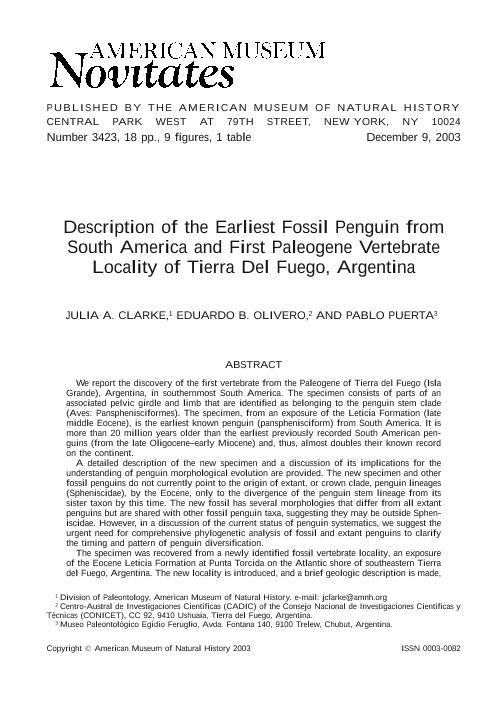Mostrar el registro sencillo del ítem
dc.contributor.author
Clarke, Julia
dc.contributor.author
Olivero, Eduardo Bernardo

dc.contributor.author
Puerta, Pablo

dc.date.available
2020-01-16T20:17:50Z
dc.date.issued
2003-12
dc.identifier.citation
Clarke, Julia; Olivero, Eduardo Bernardo; Puerta, Pablo; Description of the Earliest Fossil Penguin from South America and First Paleogene Vertebrate Locality of Tierra Del Fuego, Argentina; American Museum of Natural History; American Museum Novitates; 3423; 12-2003; 1-18
dc.identifier.issn
0003-0082
dc.identifier.uri
http://hdl.handle.net/11336/94973
dc.description.abstract
We report the discovery of the first vertebrate from the Paleogene of Tierra del Fuego (Isla Grande), Argentina, in southernmost South America. The specimen consists of parts of an associated pelvic girdle and limb that are identified as belonging to the penguin stem clade (Aves: Pansphenisciformes). The specimen, from an exposure of the Leticia Formation (late middle Eocene), is the earliest known penguin (pansphenisciform) from South America. It is more than 20 million years older than the earliest previously recorded South American penguins (from the late Oligocene–early Miocene) and, thus, almost doubles their known record on the continent. A detailed description of the new specimen and a discussion of its implications for the understanding of penguin morphological evolution are provided. The new specimen and other fossil penguins do not currently point to the origin of extant, or crown clade, penguin lineages (Spheniscidae), by the Eocene, only to the divergence of the penguin stem lineage from its sister taxon by this time. The new fossil has several morphologies that differ from all extant penguins but are shared with other fossil penguin taxa, suggesting they may be outside Spheniscidae. However, in a discussion of the current status of penguin systematics, we suggest the urgent need for comprehensive phylogenetic analysis of fossil and extant penguins to clarify the timing and pattern of penguin diversification. The specimen was recovered from a newly identified fossil vertebrate locality, an exposure of the Eocene Leticia Formation at Punta Torcida on the Atlantic shore of southeastern Tierra del Fuego, Argentina. The new locality is introduced, and a brief geologic description is made, highlighting the potential of the shallow marine sediments of the Leticia Formation for contributing to our knowledge of the Paleogene vertebrate fossil record of Tierra del Fuego, and of southern South America, generally
dc.format
application/pdf
dc.language.iso
eng
dc.publisher
American Museum of Natural History

dc.rights
info:eu-repo/semantics/openAccess
dc.rights.uri
https://creativecommons.org/licenses/by-nc-sa/2.5/ar/
dc.subject
Tierra del Fuego
dc.subject
Eocene
dc.subject
Fossil penguins
dc.subject.classification
Geología

dc.subject.classification
Ciencias de la Tierra y relacionadas con el Medio Ambiente

dc.subject.classification
CIENCIAS NATURALES Y EXACTAS

dc.title
Description of the Earliest Fossil Penguin from South America and First Paleogene Vertebrate Locality of Tierra Del Fuego, Argentina
dc.type
info:eu-repo/semantics/article
dc.type
info:ar-repo/semantics/artículo
dc.type
info:eu-repo/semantics/publishedVersion
dc.date.updated
2020-01-15T19:20:20Z
dc.journal.number
3423
dc.journal.pagination
1-18
dc.journal.pais
Estados Unidos

dc.description.fil
Fil: Clarke, Julia. American Museum of Natural History; Estados Unidos
dc.description.fil
Fil: Olivero, Eduardo Bernardo. Consejo Nacional de Investigaciones Científicas y Técnicas. Centro Austral de Investigaciones Científicas; Argentina
dc.description.fil
Fil: Puerta, Pablo. Museo Paleontológico Egidio Feruglio; Argentina
dc.journal.title
American Museum Novitates

dc.relation.alternativeid
info:eu-repo/semantics/altIdentifier/url/http://digitallibrary.amnh.org/handle/2246/2788
Archivos asociados
